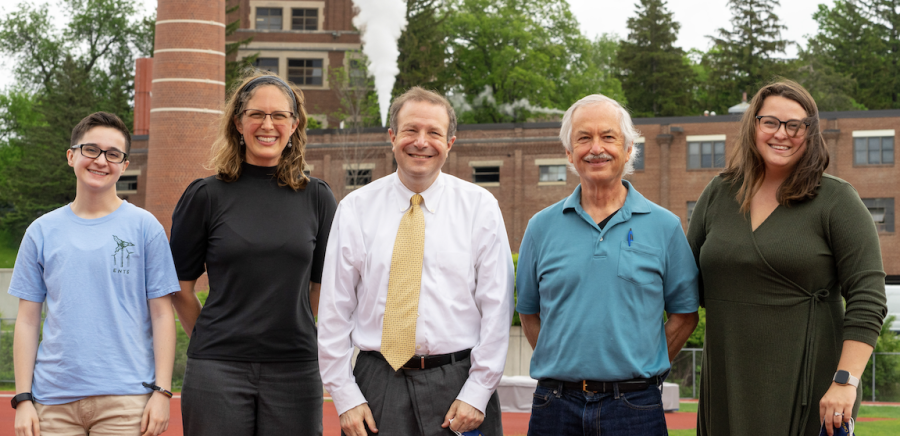At around 3 p.m. on Friday, May 21, Carleton turned off steam power for the last time ever. This concludes 111 years of using steam to fuel our campus and help students survive Minnesota winters. The college has now fully transitioned to hot water geothermal power, a shift that indicates Phase 2 of the Utility Master Plan has been completed. On May 20, just a day before the end of steam, the new geothermal system was running at approximately 600% efficiency, so hopes for the future are high. This milestone achievement was marked by the End of Steam Celebration.
Two commemorative aspects of the End of Steam celebration began before the 21st. First, on May 12 an exhibit commemorating the last 111 years of steam power opened in the Gould Library Anthanæum. Photos, artifacts and 80-year-old boiler blueprints are all on display to commemorate those who powered the steam boilers in Facilities throughout this era. Additionally, Alex Miller collected oral histories from several former boiler operators. The exhibit will remain until June 4. A recorded walkthrough, a digital exhibit of Carleton utilities history, and an online photo archive are also available.
Second, each evening this week Carleton’s smokestack was illuminated with bright lights and text reading “Carbon free by 2050” and “100 years of steam”. The lights cover the smokestack 360 degrees from top to (nearly) bottom. The lighting display was designed by Tony Storeri (’13) and executed with the help of several current students.
On May 21, festivities began with a convocation given by climate leader Dr. Ayana Elizabeth Johnson. Dr. Johnson co-hosts the podcast “How To Save a Planet,” she published the “All We Can Save” anthology, and she founded the Urban Ocean Institute think tank.
Dr. Johnson began by explaining her background in the environmental movement, which entailed “avoiding being forced to choose” a specific component of the environmental movement. Rather, she has explored the intersection of different aspects of environmentalism.
Johnson also emphasized the need to center marginalized people and communities in the environmental movement. As Johnson sees it, without social justice, “[sustainability] just won’t work.” Without an intersectional approach, “we won’t have the right people around the table coming up with solutions that work in every place and every sector.” The simple answer for Johnson was that “we need to listen.” This means dispelling the expert-centric ‘we know what’s best for you’ approach to environmentalism.
Dr. Johnson also talked at length about how collaborative climate action must be. To find your place in the movement, Johnson recommends asking yourself “What am I good at, of all the climate solutions needed, which am I the most passionate about, and what brings you joy?” Where these three intersect on a Venn Diagram is a great place to start.
15 minutes after Convocation concluded, attention turned toward Laird Stadium, where remarks were given by Sustainability Program Coordinator Alex Miller, President Steve Poskanzer, Emeritus Vice President and Treasurer Fred Rogers (’72), former CSA President Andrew Farias (’21) and Manager of Campus Energy and Sustainability Martha Larson
Each speaker offered unique insights into the geothermal energy transition for Carleton.
President Poskanzer remarked about the significance of the geothermal system, but that there remains ample work to be done in order to realize our commitments. Poskanzer added that “We would all do well to match the professionalism” of those who ran steam power at Carleton.
When Fred Rogers spoke, he reminisced about the first Earth Day in 1970, during which he was a sophomore at Carleton. Rogers highlighted the tremendous influence that campus-wide geothermal energy has had across higher education—over a dozen institutions are now following Carleton’s lead.
Andrew Farias looked back to Fall 2017, his first term at Carleton. He recalled the sounds of concrete breaking being “one of the best natural alarms” to wake up in the morning. The geothermal construction that autumn was in full swing, and despite an inconvenience then, Farias now views the project as well worth it.
Martha Larson expressed her gratitude to the hundreds of people who helped realize this transition. She gave thanks to those who worked all day in challenging conditions, MEP Associates who helped engineer the project and to the staff who operated the boilers. Larson also compared the commitment needed in sustainability to Sunrise Carleton. Their namesake, as Larson sees it, reflects how we all get up and work toward sustainable goals, sure as the sun rises; in turn, to do it all again tomorrow. Larson concluded her remarks by singing an excerpt from “I Can See Clearly Now” by Johnny Nash.
With that, attention turned toward Facilities, where steam began to get out of the building one last time. The high-pressure release created a loud noise that was hard to miss on west campus. By 3 p.m., the geiser-like blowoff had quieted to a gentle exhaust, as Carleton ushered in a new era of campus energy.
These festivities were planned by Alex Miller, Martha Larson and Sustainability Assistants Rebecca McCartney ’21 and Simran Kadam ’23. Additionally, the Communications Office, Archives Team, and Gould Library staff were instrumental in the planning process.












